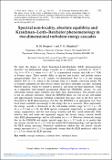Files in this item
Spectral non-locality, absolute equilibria and Kraichnan-Leith-Batchelor phenomenology in two-dimensional turbulent energy cascades
Item metadata
| dc.contributor.author | Burgess, B. H. | |
| dc.contributor.author | Shepherd, T. G. | |
| dc.date.accessioned | 2017-01-06T16:30:13Z | |
| dc.date.available | 2017-01-06T16:30:13Z | |
| dc.date.issued | 2013-06 | |
| dc.identifier | 248699890 | |
| dc.identifier | a639a5d9-0f4c-4101-9e41-b87f7bcf205f | |
| dc.identifier | 000319511200013 | |
| dc.identifier | 84880238483 | |
| dc.identifier.citation | Burgess , B H & Shepherd , T G 2013 , ' Spectral non-locality, absolute equilibria and Kraichnan-Leith-Batchelor phenomenology in two-dimensional turbulent energy cascades ' , Journal of Fluid Mechanics , vol. 725 , pp. 332-371 . https://doi.org/10.1017/jfm.2013.192 | en |
| dc.identifier.issn | 0022-1120 | |
| dc.identifier.other | ORCID: /0000-0001-9297-8003/work/54516625 | |
| dc.identifier.uri | https://hdl.handle.net/10023/10062 | |
| dc.description.abstract | We study the degree to which Kraichnan-Leith-Batchelor (KLB) phenomenology describes two-dimensional energy cascades in alpha turbulence, governed by δθ/δt + J(ψ, θ) = ν ∇2θ + f, where θ = (-Δ)α/2ψ is generalized vorticity, and ψ over bar (k)= k-α θ over bar (k) in Fourier space. These models differ in spectral non-locality, and include surface quasigeostrophic flow (alpha = 1), regular two-dimensional flow (α = 2) and rotating shallow flow (α = 3), which is the isotropic limit of a mantle convection model. We re-examine arguments for dual inverse energy and direct enstrophy cascades, including Fjørtoft analysis, which we extend to general α, and point out their limitations. Using an α-dependent eddy-damped quasinormal Markovian (EDQNM) closure, we seek self-similar inertial range solutions and study their characteristics. Our present focus is not on coherent structures, which the EDQNM filters out, but on any self-similar and approximately Gaussian turbulent component that may exist in the flow and be described by KLB phenomenology. For this, the EDQNM is an appropriate tool. Non-local triads contribute increasingly to the energy flux as α increases. More importantly, the energy cascade is downscale in the self-similar inertial range for 2.5 <α <10. At α = 2.5 and α = 10, the KLB spectra correspond, respectively, to enstrophy and energy equipartition, and the triad energy transfers and flux vanish identically. Eddy turnover time and strain rate arguments suggest the inverse energy cascade should obey KLB phenomenology and be self-similar for α <4. However, downscale energy flux in the EDQNM self-similar inertial range for α > 2.5 leads us to predict that any inverse cascade for α ≥ 2.5 will not exhibit KLB phenomenology, and specifically the KLB energy spectrum. Numerical simulations confirm this: the inverse cascade energy spectrum for α ≥ 2.5 is significantly steeper than the KLB prediction, while for α <2.5 we obtain the KLB spectrum. | |
| dc.format.extent | 40 | |
| dc.format.extent | 998316 | |
| dc.language.iso | eng | |
| dc.relation.ispartof | Journal of Fluid Mechanics | en |
| dc.subject | Isotropic turbulence | en |
| dc.subject | Turbulent flows | en |
| dc.subject | Turbulence theory | en |
| dc.subject | QC Physics | en |
| dc.subject.lcc | QC | en |
| dc.title | Spectral non-locality, absolute equilibria and Kraichnan-Leith-Batchelor phenomenology in two-dimensional turbulent energy cascades | en |
| dc.type | Journal article | en |
| dc.contributor.institution | University of St Andrews. Applied Mathematics | en |
| dc.identifier.doi | https://doi.org/10.1017/jfm.2013.192 | |
| dc.description.status | Peer reviewed | en |
This item appears in the following Collection(s)
Items in the St Andrews Research Repository are protected by copyright, with all rights reserved, unless otherwise indicated.

